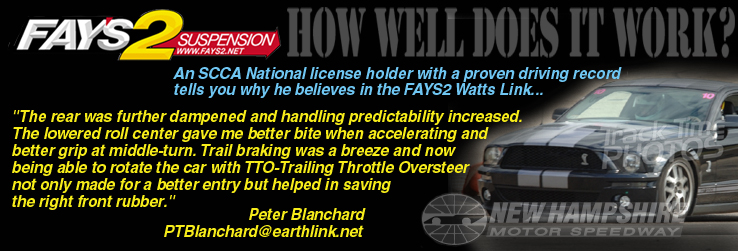

Read how the FAYS2 Suspension Watts Link works and how its adjustability can give you a better handling car.
Driver Background
SCCA Road Racing for a decade
SCCA National license, competed in and held SCCA Pro series license
A handful of Northeast Season Championships in SRF
A few thousand laps around NHMS
A dozen wins at NHMS
Set lap record at NHMS in SRF
Instructor for SCDA
New Hampshire Motor Speedway
Used "South Chicane" configuration. NHMS is choppy, primarily left hand, 1.3 mile road course full of abrupt transitions, pavement changes, banking, an off-camber turn, hard braking, abrupt uphill and downhill compressions when crossing over the NASCAR back straight. Turn 1 is a transition down from the banking for NASCAR Turn1 (similar to Daytona's road course Turn 1). South Chicane course turns hard left and drops off the banking, into the infield, through a left/right/left chicane and then launches out onto the back straight before crossing over the back straight onto the back half of the road course.
Day 1- dry, sunny, mid 70's, tire pressures hot = 37
Stock GT500 -panhard bar, no Watts link
As expected, the rear end behaved erratically - hopped, darted, lots of body roll. Hands and feet were pretty busy. Car was a handful, pushed on entry, loose on throttle-on exit. Other than the "amusement" of sliding around and counter-steering, the stock vehicle, for track purposes is an ill-handling brick with a blower.
Day 2- started damp but dried out by middle of 1st session, sunny, low 60's, tire pressures hot = 37
Stock GT500 with Fays2 watts link
Session 1: Fays2 neutral setting - propeller was centered in middle hole.
Car was MUCH more behaved. Less yaw, less roll, less hop. Although the push did not go away (nor should it), the car was more stable and the best description was the rear was significantly dampened. That, in turn, instilled some confidence and predictability and I could counter the push-on-entry by trail braking. The car still rolled like a boat but the Fays2 made the roll more consistent from side to side. That consistency was very noticeable in the left/right/left chicane. The car would roll over and load up, but the unloading and transition to the right and then again back to the left was predictable and I could roll the car through the chicane with some natural rhythm. Acceleration on exit will always be exhilarating with this car. Always remember the Friction Circle-you want to mash the go pedal?-unwind your hands. With that being said, compared to the panhard bar, I was able to get the power down more consistently on the various exits.
Session 2: Fays2 lowered roll center-propeller was lowered one hole below neutral.
Now we're talking!! Yes, it's still a dull blunt instrument but this car was actually becoming FUN to drive. (Note: if you wanted a scalpel for a track car-you should have bought an Elise.) What I felt in Session 1 was now enhanced across the entire track. The rear was further dampened and handling predictability increased. The lowered roll center gave me better bite when accelerating and better grip at middle-turn. Trail braking was a breeze and now being able to rotate the car with TTO-Trailing Throttle Oversteer not only made for a better entry but helped in saving the right front rubber.
Session 3: Fays 2 raised roll center-propeller was raised one hole above neutral (raised 2 holes above Session 2 setting)
If you want to try your hand in a drifting competition, try this setup. This was a handful. I mention the drifting because the setup was breaking all four tires loose and it was a full four wheel slide through the corner. The great bite and grip I had from the previous setup was completely gone. There was a lot pedaling trying to accelerate the car and still keep it under me. But here is the interesting point on this setup. Although it was a handful, it was a predictable. No snap oversteer, no real scary moments, just a lot of sliding, pedaling AND slower lap times. It felt like I was running around on bias-ply's.
Summary:
Hands down, a Watts link positively improves the dynamics and handling of the car. "Dampened", "behaved", "settled" were all terms I used to describe the characteristics of a Watts link in Sessions 1, 2 and 3. However, the word I used the most is "predictable." Adjusting the roll center height changes the characteristic of the car but no matter the setting, the car was predictable and controllable. What is also really important is that there was a Session 2 and Session 3. If I used a different link setup with no adjustability I still would have experienced the benefit of the a Watts, but would have not been able to explore the handling characteristics of adjustable roll center and would not have had the advantage while driving the car in Session 2. For those of you with adjustable shocks, adjustable struts, programmable chips, etc.-why would you want to bolt on a non-adjustable Watts?
Now, ignore all the on-track feedback for a moment and let's talk about commuting. My comments regarding the ride home on the public roads are the same as what I felt on the track. No, I didnŐt have to worry about front end push while turning into my driveway nor having to trail brake into Dunkin Donuts. But the rear end was no longer jumping erratically over un-even pavement and expansion joints-it was dampened, settled and predictable. My wife even noticed the improvement while riding shotgun. I left the track having reset roll center to one-below-neutral. Right now, that's my daily driver setup. Next time at that track, I'll compare -1 and -2 below neutral.
Peter
ptblanchard@earthlink.net